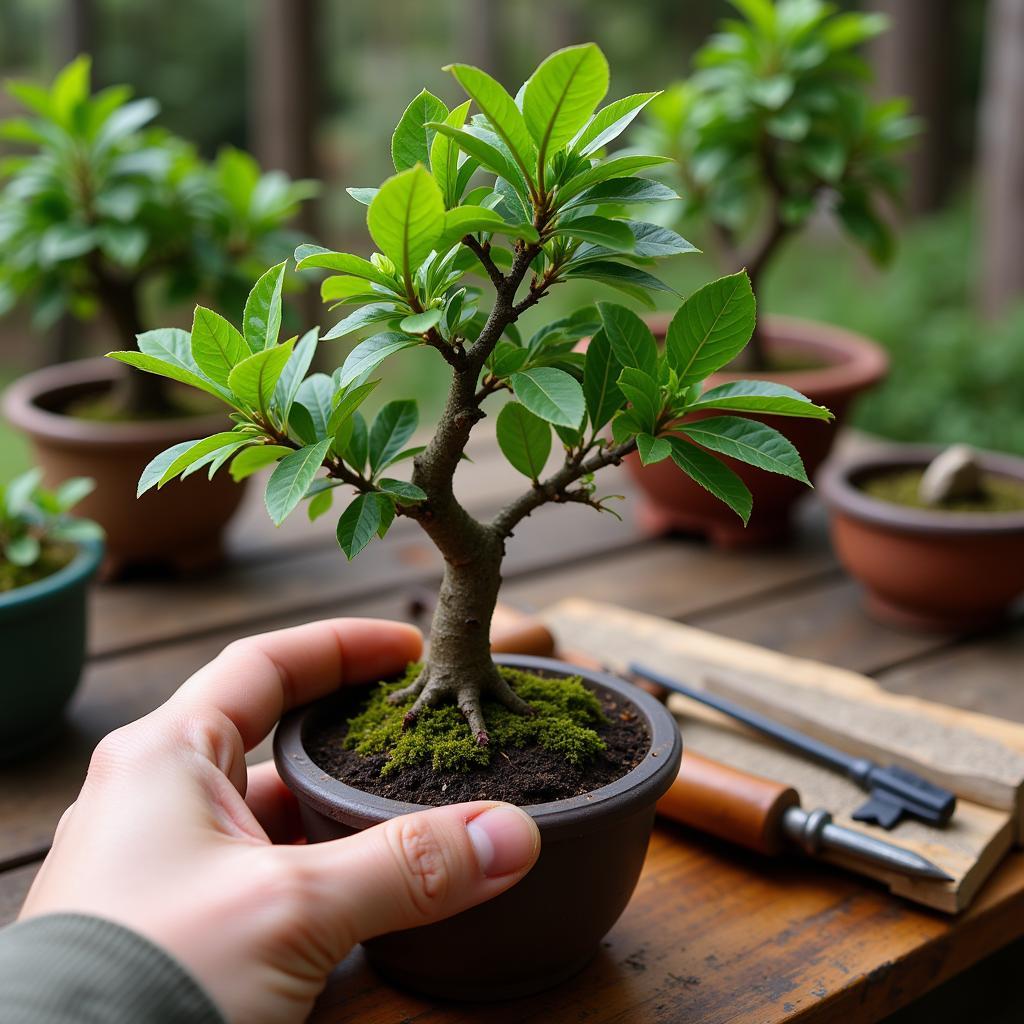Bonsai Horse Chestnut Trees offer a unique way to enjoy the beauty of these majestic trees in a compact form. This comprehensive guide explores the art of cultivating and caring for a bonsai horse chestnut tree, providing you with all the essential knowledge to nurture your own miniature marvel.
Understanding the Bonsai Horse Chestnut
Bonsai horse chestnut trees, also known as Aesculus hippocastanum bonsai, are not a naturally dwarf variety. They are created by carefully pruning and training standard horse chestnut trees to maintain a miniature size. This process requires patience and dedication, but the reward is a stunning, living work of art.
Choosing the Right Horse Chestnut for Bonsai
Selecting a suitable horse chestnut for bonsai cultivation is crucial. Look for young, healthy trees with vigorous growth. Consider the tree’s overall shape and branching structure, envisioning its potential as a bonsai.
 Choosing the Right Horse Chestnut for Bonsai
Choosing the Right Horse Chestnut for Bonsai
Cultivating Your Bonsai Horse Chestnut
Creating a bonsai horse chestnut requires a combination of specific techniques, including pruning, wiring, and repotting. These practices help shape the tree and maintain its miniature size.
Pruning and Shaping Techniques
Pruning is essential for shaping and maintaining the size of your bonsai horse chestnut. Regularly prune new growth to maintain the desired silhouette. Also, remove any crossing or inward-growing branches to promote a healthy and aesthetically pleasing structure.
Wiring and Shaping the Branches
Wiring involves carefully wrapping wire around the branches to guide their growth and create the desired shape. This technique requires patience and precision, as it’s crucial to avoid damaging the branches. Copper wire is commonly used due to its flexibility and strength.
Repotting and Root Pruning
Repotting your bonsai horse chestnut is necessary to refresh the soil and prevent the roots from becoming pot-bound. This process usually involves pruning the roots to maintain a balanced root system and encourage healthy growth. Repotting is typically done every two to three years, depending on the tree’s growth rate.
Essential Care for Bonsai Horse Chestnut Trees
Just like their full-sized counterparts, bonsai horse chestnut trees require specific care to thrive. Providing the right amount of sunlight, water, and nutrients is crucial for their health and longevity.
Sunlight and Watering Requirements
Bonsai horse chestnut trees thrive in full sun to partial shade. They require regular watering, especially during the growing season. Ensure that the soil is well-draining to prevent root rot.
Fertilizing Your Bonsai Horse Chestnut
Fertilizing your bonsai horse chestnut is essential for providing the necessary nutrients for healthy growth. Use a balanced bonsai fertilizer during the growing season, following the manufacturer’s instructions.
 Watering a Bonsai Horse Chestnut
Watering a Bonsai Horse Chestnut
Troubleshooting Common Issues
Even with meticulous care, bonsai horse chestnut trees can sometimes face challenges. Understanding common problems and their solutions can help you maintain your tree’s health.
Dealing with Pests and Diseases
Bonsai horse chestnut trees can be susceptible to certain pests and diseases. Regularly inspect your tree for any signs of infestation or disease. Treat any problems promptly using appropriate insecticides or fungicides.
Conclusion
Cultivating a bonsai horse chestnut tree can be a rewarding and enriching experience. With patience, dedication, and the knowledge provided in this guide, you can create a stunning miniature representation of this magnificent tree. Enjoy the journey of nurturing your bonsai horse chestnut and watching it evolve into a living work of art.
FAQs
- How often should I water my bonsai horse chestnut?
- What type of fertilizer is best for bonsai horse chestnut trees?
- How do I prune my bonsai horse chestnut to maintain its shape?
- When should I repot my bonsai horse chestnut?
- What are the common pests and diseases that affect bonsai horse chestnut trees?
- How can I protect my bonsai horse chestnut from extreme weather conditions?
- Where can I find more information about bonsai horse chestnut care?
Other relevant articles on our website include:
- Bonsai Basics: A Beginner’s Guide
- Understanding Bonsai Soil and Repotting Techniques
- Common Bonsai Pests and Diseases
Need assistance? Contact us at Phone Number: 0772127271, Email: [email protected], or visit our location: QGM2+WX2, Vị Trung, Vị Thuỷ, Hậu Giang, Việt Nam. Our customer support team is available 24/7.